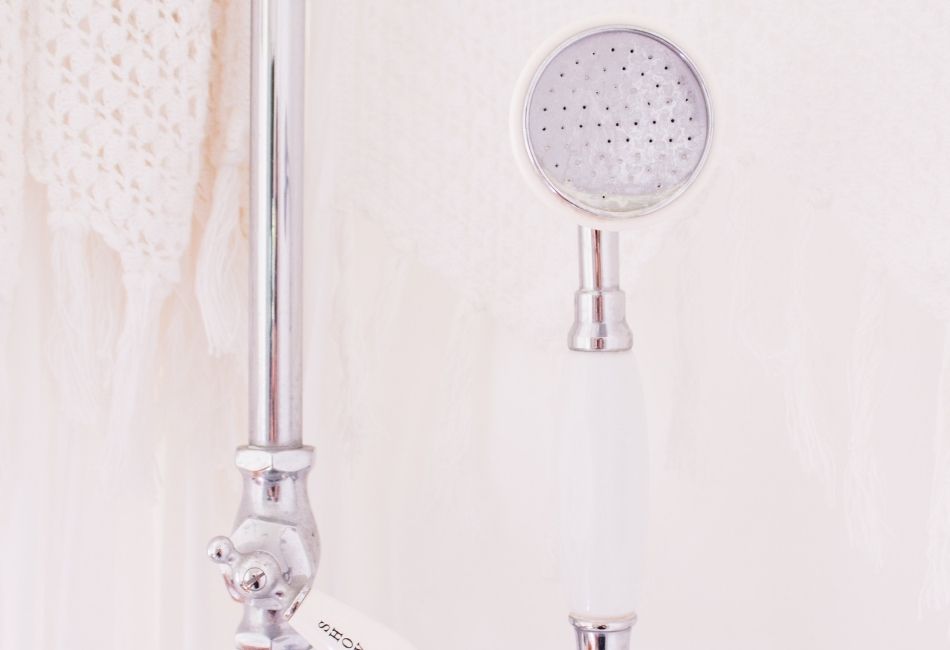Limescale in showerheads is a common occurrence. It is not fun showering with a showerhead full of limescale because you can experience reduced water pressure through the nozzles as well as water flowing in all directions other than down.
Limescale is often immediately visible but sometimes they might be built up within the head. The buildup in itself is not harmful to humans but the sight of it in the bathroom can be unpleasant and nauseating so it is important to descale your showerheads from time to time.
So how do you clean limescale from showerheads?
- By using vinegar to remove limescale from showerheads
- By using baking soda to remove limescale from showerheads
- By using Lemon
- By using specialised limescale removers
What Does Limescale Look Like?
Limescale can be visible in many forms and colours. It mostly shows as white, chalky but hard deposits on the surface of your showerheads, inside of kettles, washing machines, tap, sinks, coloured plastics and many other surfaces. It can also appear as red-brown-like colour, like rust.
What Causes Limescale On Showerheads?
Limescale is formed because of hard water coming through your showerheads. Hard water is a term given to water with high mineral contents such as calcium and magnesium and these minerals buildup over time.
Whenever we finish taking shower, the water evaporates leaving behind these minerals. The minerals then stick together and over time, solidify to form limescale around the showerhead, and inside the shower nozzles. It must be noted that hard water is not harmful to our health.
How To Safely Remove Limescale From Showerhead
As discussed earlier, having limescale build-up on your showerhead can be an unsightly thing to see. Again the experience of reduced water pressure and water flowing in all directions can be irritating. Therefore, it is necessary for you to descale your showerheads from time to time.
There are a couple of easy ways to do this and I will share with you 4 ways to get rid of limescale on your showerheads.
1. Using Vinegar To Remove Limescale From Showerheads
One of the easiest ways to descale your showerheads is by using white vinegar solution. Vinegar is acidic therefore has properties that help remove or dissolve limescale buildup. It is an easy process to descale your showerheads with vinegar. Let’s go through it step by step.
Things Needed
- Rubber gloves
- White Vinegar
- Soft Cloth
- Rubber Bowl / Plastic Bag
- Rubber Band
- Clean Sponge
- Old Toothbrush
Procedure:
Step 1
- Wear gloves
Step 2
- Fill the rubber bowl or plastic bag with distilled white vinegar. The reason for either the rubber bowl or plastic bag will be explained in later steps.
- Make sure there is enough white vinegar to submerge the showerhead.
- Be sure not to use malt vinegar or brown vinegar as they may stain.
Step 3
- Now carefully unscrew the showerhead from the hose.
- Be careful not to misplace the small rubber washer within the hose connector.
- If your shower head is fixed and cannot be removed, you can skip this step.
Step 4
- Immerse the unscrewed showerhead in the bowl filled with vinegar. Make sure all the surface covered with limescale is completely immersed in the vinegar solution.
- If your showerhead cannot be detached from the hose, attach the rubber bag filled with vinegar over the showerhead and secure it firmly with a rubber band at the top of the rubber bag.
- Leave the showerhead in the vinegar solution for at least one hour to completely dissolve the limescale deposits.
Step 5
- Remove the soaked showerhead and rinse with clean water.
Step 6
- Remove any excess deposits from the nozzles using the old toothbrush. The vinegar should have softened these making them very easy to remove.
- Give the showerhead a clean scrub with a clean sponge to remove any remaining deposits.
- Rinse thoroughly once again in cool water.
- With fixed showerheads, turn on the tap for about 15 seconds to flush out any extra limescale deposits left inside.
Step 7
- Polish the showerhead with a soft cloth
Step 8
- Carefully attach the showerhead to its hose, making sure it is securely fixed to prevent any leakages.
2. Using Baking Soda To Remove Limescale From Showerheads
You can use baking soda to remove limescale deposits if that is all you have. Baking soda can do the job perfectly and here is a step by step guide to using baking soda to get rid of limescale deposits on your showerheads.
Things Needed
- Rubber Gloves
- Baking Soda
- Bowl of clean water
- Old Toothbrush
- Clean Sponge
- Soft Cloth
Procedure
Step 1
- Wear gloves
Step 2
- Remove the showerhead from its hose
- Skip this step if the showerhead is fixed
Step 3
- Mix three tablespoons of baking soda to five tablespoons of water in a bowl
Step 4
- Now apply the baking soda mixture to the stains
- Give it about an hour to soften the stains
Step 5
- With a clean sponge, clean the treated area until removed
- Use the old toothbrush to remove any remaining deposits from the nozzles.
Step 6
- Wash the showerhead thoroughly with clean water and polish with a soft cloth.
Step 7
- Fix the showerhead to its hose and enjoy your shower
3. Using Lemon To Remove Limescale From Showerheads
One of the cheapest and easiest ways to remove limescale from showerheads is by using lemon. Lemon can remove alkaline stains like limescale. The acidity of lemon reacts with the limescale, breaking it down for easy cleaning. To use lemon to get rid of limescale, follow these simple steps.
Things Needed
- Lemon
- Old toothbrush
- Microfibre cloth
Procedure
Step 1
- Cut Lemon in half and squeeze out the juice.
Step 2
- Apply the lemon juice all over the stained area and leave let it sit for at least 30 minutes. If the lemon juice you get is very little and will not be enough to cover the affected area, get an additional lemon.
Step 3
- Using the old toothbrush, firmly scrub off the limescale until all is removed and you have a clean surface.
Step 4
- Finally, rinse the showerhead with clean soft water and polish with a microfibre cloth.
4. Using Specialised Limescale Removers To Remove Limescale From Showerheads
There are many specialised limescale removers available online and in supermarkets. Sometimes if limescale builds up for a long time, it may be difficult to remove. If you’ve got a heavy buildup that is resistant to vinegar, baking soda or lemon, it may require specialised chemical limescale remover. They may be the ultimate go-to against such stubborn stains.
It must be noted that these chemical limescale removers may be harsh so read the instructions very well before use.
Tips For Using Specialised Limescale Removers
- Always put on gloves before using chemicals
- Some chemicals are not good for some materials so read the labels carefully.
- Do not soak the showerhead for a long period of time as it may take less time to dissolve the deposits.
- Do not spray chemicals overhead as they may accidentally get into your eyes.
- Wash the showerheads thoroughly with clean water before use
- Finally, wash your hands with soap and water after chemical use.
How To Prevent Limescale Build Up In Your Showerhead
We have gone through 4 different methods of removing limescale, but is there a way to prevent or reduce its occurrence? Yes, there is. Here are some tips for preventing limescale buildup in your showerhead.
- After using the shower, take a few seconds to wipe dry any remaining water deposits on the showerhead. Yes, this solution might be timely but we all agree it is inexpensive.
- Remove the showerhead at least once a week during the general bathroom cleaning to get rid of any limescale traces before it builds up heavily.
- You might also consider installing a water softener.


